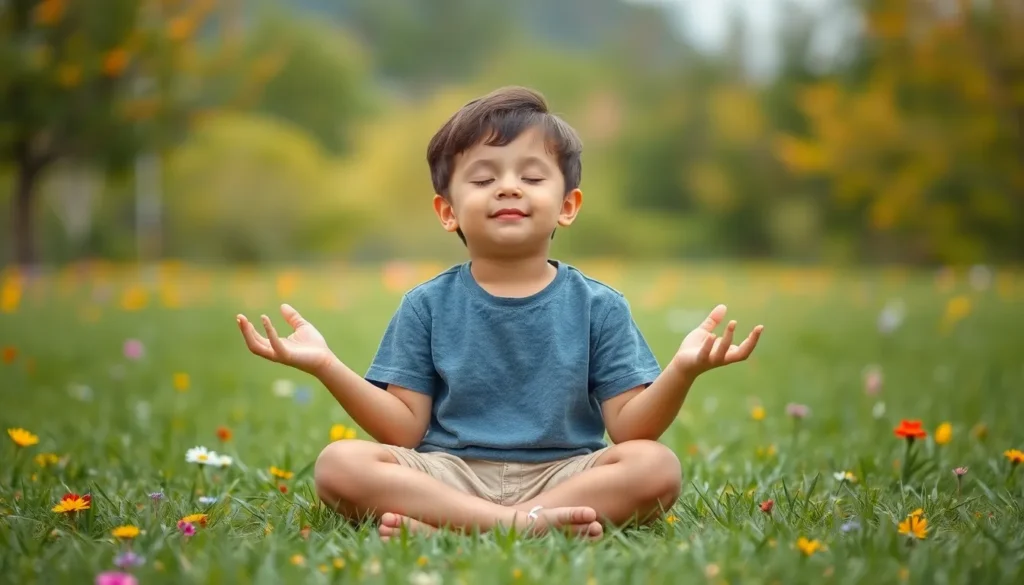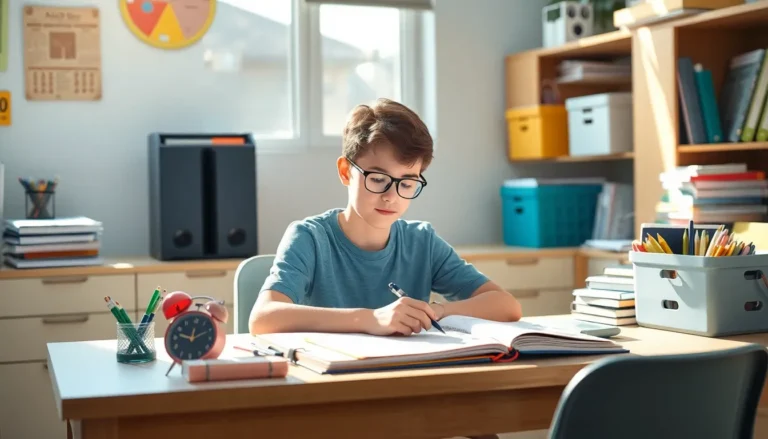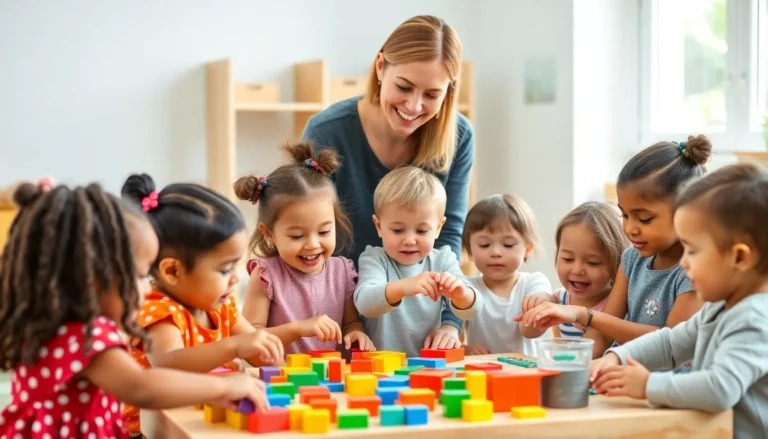Table of Contents
ToggleIn today’s fast-paced world, children often face overwhelming stress and distractions. Mindfulness activities offer a powerful solution, helping kids cultivate focus, emotional regulation, and resilience. By engaging in simple yet effective practices, children can learn to navigate their feelings and develop a deeper connection with the present moment.
From breathing exercises to creative visualization, these activities not only promote relaxation but also enhance overall well-being. Incorporating mindfulness into daily routines can empower children to manage anxiety and improve their concentration, setting the stage for healthier emotional development. Discover how these engaging mindfulness activities can transform a child’s approach to life’s challenges and foster a sense of inner peace.
Benefits of Child Mindfulness Activities
Mindfulness activities offer significant advantages for children’s emotional and cognitive development. These practices equip children with essential skills to navigate their feelings and improve their overall focus.
Enhancing Emotional Regulation
Mindfulness activities foster emotional regulation in children. Such exercises help them recognize and understand their emotions, allowing for healthier responses. Breathing techniques and guided imagery serve as tools for managing overwhelming feelings. This practice reduces impulsivity and increases awareness, which leads to more thoughtful actions in challenging situations.
Improving Focus and Attention
Mindfulness activities enhance children’s focus and attention span. Simple techniques, like mindful breathing and body scans, train their minds to concentrate on the present moment. Increased awareness results in improved academic performance and better engagement in daily tasks. Regular practice develops the capacity to sustain attention, which is critical in a distracting environment.
Types of Child Mindfulness Activities

Mindfulness activities for children come in various forms, helping them cultivate awareness and emotional management. The following sections detail specific types of activities that can promote mindfulness in children.
Breathing Exercises
Breathing exercises focus on the breath as a tool for enhancing awareness. Techniques such as deep belly breathing help children learn to control their breathing, fostering relaxation. For instance, the “5-7-8 technique” encourages children to inhale deeply for five seconds, hold for seven seconds, and exhale for eight seconds. This practice reduces anxiety and stress. Another example includes bubble breathing, where children pretend to blow bubbles as they exhale, making the exercise fun and engaging.
Mindful Movement
Mindful movement combines physical activity with meditation principles. Yoga poses tailored for children, such as tree pose and cat-cow, promote body awareness and flexibility. These movements teach them to connect their breath with physical motions, enhancing focus. Dance or martial arts also serve as mindful movement activities, allowing children to express themselves while being present in the moment. Incorporating stretches during breaks can further enhance relaxation and concentration.
Guided Imagery
Guided imagery uses visualization techniques to spark creativity and calmness. This activity invites children to imagine a peaceful scene, such as a beach or forest, encouraging them to engage their senses. For example, a guided session might prompt children to visualize the warmth of the sun or the sound of waves. Practicing this regularly helps children develop their imagination while cultivating a sense of tranquility. Furthermore, storytelling that encourages vivid imagery can enhance children’s ability to focus and relax.
How to Implement Mindfulness at Home
Implementing mindfulness at home enhances children’s emotional and cognitive development. Establishing routines and engaging in outdoor activities can solidify these beneficial practices.
Creating a Mindfulness Routine
Creating a mindfulness routine involves consistency and simplicity. Parents can start by setting aside 5-10 minutes each day for mindfulness activities. Choose specific times, such as morning or bedtime, to integrate these practices seamlessly into daily life.
- Set a Time: Choose a consistent time every day for mindfulness.
- Choose Activities: Select a variety of mindfulness activities, such as breathing exercises or guided imagery.
- Use Reminders: Implement visual reminders, like sticky notes, to encourage participation.
- Involve Everyone: Encourage the whole family to join, fostering a supportive environment.
- Reflect Together: After each session, spend a minute discussing feelings or experiences to reinforce learning.
Engaging in Outdoor Mindfulness
Engaging in outdoor mindfulness connects children with nature, enhancing the calming effects of these practices. Outdoor activities can include mindful walking, nature observation, or simple outdoor games.
- Mindful Walking: Encourage children to walk slowly and observe their surroundings, focusing on sights, sounds, and smells.
- Nature Observation: Create opportunities for children to spend time observing plants and animals, promoting a sense of wonder.
- Grounding Exercises: Incorporate activities that connect children to the earth, like feeling grass between their toes or listening to the wind.
- Nature Scavenger Hunts: Organize scavenger hunts that require focused attention on finding specific items in nature.
- Mindfulness Games: Utilize outdoor games that promote mindfulness while engaging in physical activity, such as yoga or tai chi.
Integrating these strategies fosters mindfulness at home, contributing to healthier emotional and cognitive development in children.
Mindfulness Activities for Different Age Groups
Mindfulness activities can be tailored to suit the developmental stages of children. Engaging in age-appropriate practices enhances their ability to focus, regulate emotions, and cultivate inner peace.
Preschoolers
Preschoolers benefit from simple, engaging mindfulness activities that capture their attention. Activities can include:
- Breathing Buddies: Children place a soft toy on their stomach while lying down. As they inhale and exhale, they watch the toy rise and fall, fostering awareness of their breath.
- Nature Scavenger Hunt: Exploring nature with a checklist encourages focus. Items like leaves, rocks, and flowers can be observed mindfully.
- Stretching and Movement: Simple yoga poses or animal movements, such as cat-cow or butterfly stretches, promote body awareness and relaxation.
Elementary School Children
Elementary school children can handle more structured mindfulness practices that further support their emotional and cognitive development. Suggested activities include:
- Mindful Coloring: Using mandalas or intricate designs, children focus on colors and patterns, reducing anxiety and enhancing creativity.
- Five Senses Exercise: Children identify five things they see, four things they can touch, three sounds they hear, two smells, and one taste. This practice grounds them in the present moment.
- Gratitude Journaling: Children write or draw three things they are grateful for each day, reinforcing positive thinking and emotional regulation.
Teenagers
Teenagers face unique stressors and can benefit from more advanced mindfulness techniques. Effective activities include:
- Guided Meditation: Utilizing apps that offer short guided meditation sessions helps improve focus and reduce stress. Sessions ranging from 5 to 15 minutes fit well into busy schedules.
- Mindful Journaling: Reflecting on thoughts and feelings with prompts encourages deeper self-awareness and emotional processing.
- Digital Detox: Allocating specific times for unplugging from devices promotes mindfulness. Engaging in nature walks, reading, or spending time with family without distractions fosters relaxation and emotional balance.
Incorporating these activities at each developmental stage nurtures mindfulness, promoting healthier emotional and cognitive growth in children and teenagers.
Mindfulness activities offer invaluable tools for children to navigate the complexities of modern life. By integrating these practices into daily routines, children can cultivate emotional awareness and resilience. The benefits extend beyond immediate stress relief, fostering long-term improvements in focus and emotional regulation.
Parents and caregivers play a crucial role in creating supportive environments for mindfulness. By tailoring activities to suit different age groups and involving the whole family, they can enhance the effectiveness of these practices. Ultimately, embracing mindfulness not only nurtures children’s well-being but also equips them with essential skills for a balanced life.





